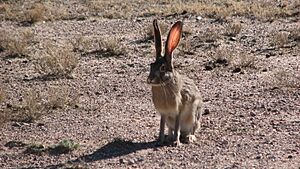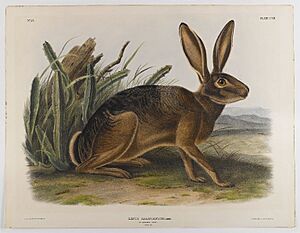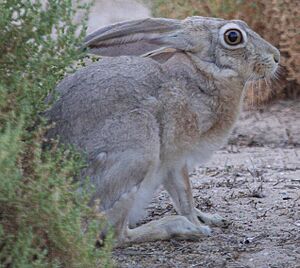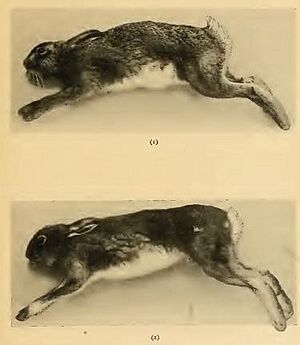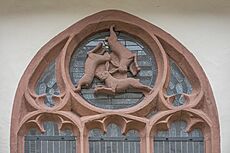Hare facts for kids
Quick facts for kids Hares |
|
|---|---|
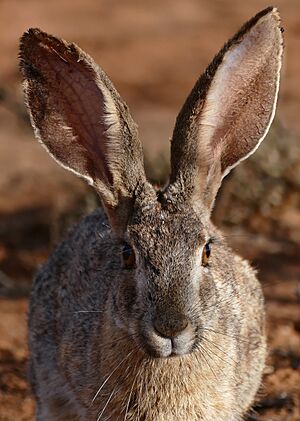 |
|
| Scrub hare (Lepus saxatilis) | |
| Scientific classification |
|
| Kingdom: | Animalia |
| Phylum: | Chordata |
| Class: | Mammalia |
| Order: | Lagomorpha |
| Family: | Leporidae |
| Genus: | Lepus Linnaeus, 1758 |
| Type species | |
| Lepus timidus Linnaeus, 1758
|
|
| Species | |
|
See text |
|
Hares and jackrabbits are mammals belonging to the genus Lepus. They are herbivores and live solitarily or in pairs. They nest in slight depressions called forms, and their young are able to fend for themselves shortly after birth. The genus includes the largest lagomorphs. Most are fast runners with long, powerful hind legs, and large ears that dissipate body heat. Hare species are native to Africa, Eurasia and North America. A hare less than one year old is called a "leveret".
Members of the Lepus genus are considered true hares, distinguishing them from rabbits which make up the rest of the Leporidae family. However, there are five leporid species with "hare" in their common names which are not considered true hares: the hispid hare (Caprolagus hispidus), and four species known as red rock hares (Pronolagus). Conversely, several Lepus species are called "jackrabbits", but classed as hares rather than rabbits. The pet known as the Belgian hare is a domesticated European rabbit which has been selectively bred to resemble a hare.
Contents
Biology
Hares are swift animals and can run up to 80 km/h (50 mph) over short distances. Over longer distances, the European hare (Lepus europaeus) can run up to 55 km/h (35 mph). The five species of jackrabbits found in central and western North America are able to run at 65 km/h (40 mph) over longer distances, and can leap up to 3 m (10 ft) at a time.
Normally a shy animal, the European brown hare changes its behavior in spring, when it can be seen in daytime chasing other hares. This appears to be competition between males (called bucks) to attain dominance for breeding. During this spring frenzy, animals of both sexes can be seen "boxing", one hare striking another with its paws. This behavior gives rise to the idiom "mad as a March hare".
Hares, like all leporids, have jointed, or kinetic, skulls, unique among mammals.
Differences from rabbits
Hares are generally larger than rabbits, with longer ears, and have black markings on their fur. They have 48 chromosomes, while rabbits have 44. Hares have not been domesticated, while some rabbits are raised for food and kept as pets.
Some rabbits live and give birth underground in burrows, with many burrows in an area forming a warren. Other rabbits and hares live and give birth in simple forms (shallow depression or flattened nest of grass) above the ground. Hares usually do not live in groups. Young hares are adapted to the lack of physical protection, relative to that afforded by a burrow, by being born fully furred and with eyes open. They are hence precocial, able to fend for themselves soon after birth. By contrast, rabbits are altricial, being born blind and hairless.
Diet
Easily digestible food is processed in the gastrointestinal tract, expelling the waste as regular feces. For nutrients that are harder to extract, hares, like all lagomorphs, ferment fiber in the cecum and expel the mass as cecotropes, which they ingest again, a practice called cecotrophy or refection. The cecotropes are absorbed in the small intestine to use the nutrients.
Classification
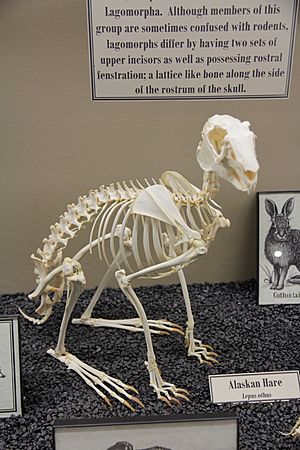
- Genus Lepus
- Subgenus Macrotolagus
- Antelope jackrabbit, Lepus alleni
- Subgenus Poecilolagus
- Snowshoe hare, Lepus americanus
- Subgenus Lepus
- Arctic hare, Lepus arcticus
- Alaskan hare, Lepus othus
- Mountain hare, Lepus timidus
- Subgenus Proeulagus
- Black jackrabbit, Lepus insularis
- Desert hare, Lepus tibetanus
- Tolai hare, Lepus tolai
- Subgenus Eulagos
- Broom hare, Lepus castroviejoi
- Yunnan hare, Lepus comus
- Korean hare, Lepus coreanus
- European hare, Lepus europaeus
- Manchurian hare, Lepus mandshuricus
- Ethiopian highland hare, Lepus starcki
- Subgenus Sabanalagus
- Ethiopian hare, Lepus fagani
- African savanna hare, Lepus victoriae
- Subgenus Indolagus
- Hainan hare, Lepus hainanus
- Indian hare, Lepus nigricollis
- Burmese hare, Lepus peguensis
- Subgenus Sinolagus
- Chinese hare, Lepus sinensis
- Subgenus Tarimolagus
- Yarkand hare, Lepus yarkandensis
- Incertae sedis
- Tamaulipas jackrabbit, Lepus altamirae
- Japanese hare, Lepus brachyurus
- Black-tailed jackrabbit, Lepus californicus
- White-sided jackrabbit, Lepus callotis
- Cape hare, Lepus capensis
- Corsican hare, Lepus corsicanus
- Tehuantepec jackrabbit, Lepus flavigularis
- Granada hare, Lepus granatensis
- Abyssinian hare, Lepus habessinicus
- Mediterranean hare, Lepus mediterraneus
- Woolly hare, Lepus oiostolus
- West Sahara hare, Lepus saharae
- Scrub hare, Lepus saxatilis
- Moroccan hare, Lepus schlumbergeri
- White-tailed jackrabbit, Lepus townsendii
- Subgenus Macrotolagus
In human culture
Food
Meat
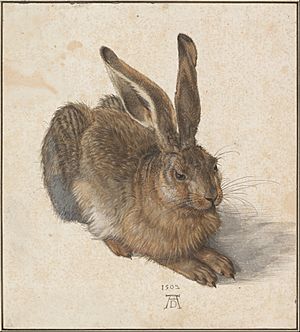
Hares and rabbits are plentiful in many areas, adapt to a wide variety of conditions, and reproduce quickly, so hunting is often less regulated than for other varieties of game. They are a common source of protein worldwide. Because of their extremely low fat content, they are a poor choice as a survival food.
Hares can be prepared in the same manner as rabbits—commonly roasted or parted for breading and frying.
Hasenpfeffer (also spelled Hasenfeffer) is a traditional German stew made from marinated rabbit or hare, seasoned with black pepper (German Pfeffer) and other spices. Wine or vinegar is also a prominent ingredient, to lend a sourness to the recipe.
Lagos stifado (Λαγός στιφάδο)—hare stew with pearl onions, vinegar, red wine, and cinnamon—is a much-prized dish enjoyed in Greece and Cyprus and communities in the diaspora.
The hare (and in recent times, the rabbit) is a staple of Maltese cuisine. The dish was presented to the island's Grandmasters of the Sovereign Military Order of Malta, as well as Renaissance Inquisitors resident on the island, several of whom went on to become pope.
According to Jewish tradition, the hare is among mammals deemed not kosher, and therefore not eaten by observant Jews. Muslims deem coney meat (rabbit, pika, hyrax) to be halal, and in Egypt, hare and rabbit are popular meats for mulukhiyah (jute leaf soup), especially in Cairo.
Taming
No extant domesticated hares exist. However, hare remains have been found in a wide range of human settlement sites, some showing signs of use beyond simple hunting and eating:
- A European brown hare was buried alongside an older woman in Hungary mid fifth millennium BC.
- 12 Mountain hare metapodials were found in a Swedish grave from third millennium BC.
- The Tolai hare (originally described as a Cape hare, amended according to range) was tamed by northern Chinese people in the neolithic period (~third millennium BC) and fed millets.
In mythology and folklore
The hare in African folk tales is a trickster; some of the stories about the hare were retold among enslaved Africans in America and are the basis of the Br'er Rabbit stories. The hare appears in English folklore in the saying "as mad as a March hare" and in the legend of the White Hare that alternatively tells of a witch who takes the form of a white hare and goes out looking for prey at night or of the spirit of a broken-hearted maiden who cannot rest and who haunts her unfaithful lover.
The constellation Lepus is taken to represent a hare.
The hare was once regarded as an animal sacred to Aphrodite and Eros. Live hares were often presented as a gift of love. In European witchcraft, hares were either witches' familiars or a witch who had transformed themself into a hare. Now pop mythology associates the hare with the Anglo-Saxon goddess Ēostre as an explanation for the Easter Bunny, but is wholly modern in origin and has no authentic basis.
In European tradition, the hare symbolises the two qualities of swiftness and timidity. The latter once gave the European hare the Linnaean name Lepus timidus that is now limited to the mountain hare.
In literature and art
Three hares
A study in 2004 followed the history and migration of a symbolic image of three hares with conjoined ears. In this image, three hares are seen chasing each other in a circle with their heads near its centre. While each of the animals appears to have two ears, only three ears are depicted. The ears form a triangle at the centre of the circle and each is shared by two of the hares. The image has been traced from Christian churches in the English county of Devon right back along the Silk Road to China, via western and eastern Europe and the Middle East. Before its appearance in China, it was possibly first depicted in the Middle East before being reimported centuries later. Its use is associated with Christian, Jewish, Islamic and Buddhist sites stretching back to about 600 AD.
Place names
The hare has given rise to local place names, as they can often be observed in favoured localities. An example in Scotland is "Murchland", murchen being a Scots word for a hare.
See also
 In Spanish: Liebres para niños
In Spanish: Liebres para niños


